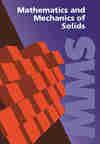大变形多孔介质中达西定律的福克海默修正分数化
IF 1.7
4区 工程技术
Q3 MATERIALS SCIENCE, MULTIDISCIPLINARY
引用次数: 0
摘要
本研究对饱和多孔介质中的间隙流体的流动进行了理论和数值研究,主要目的是模拟生物仿生材料,并假定其动态机制不同于达西定律,正如通常在生物力学情景中所假设的那样。我们研究的主要方面是一种猜想,根据这种猜想,在多孔介质的特定力学状态下,流体表现出两种偏离达西定律的情况。一种是由于惯性力导致的流体孔隙尺度动力学特征。这可以通过对达西定律进行福赫海默修正来解决,福赫海默修正在流体过滤速度与描述流体和固体基质之间相互作用的耗散力之间引入了非线性关系。与经典达西定律存在差异的第二个原因是孔隙尺度对流动的干扰,例如流体路径受阻或孔隙堵塞,导致阻力与过滤速度之间出现时间延迟。最近,有人提出了通过具有分数算子的构成定律来描述这种延迟的模型。据我们所知,上述行为都是单独或在小变形情况下进行研究的,而我们提出了一个流体在发生大变形的可变形多孔介质中流动的模型,在这个模型中,流体运动服从分数化福克海默修正。在回顾了福克海默公式之后,我们介绍了达西-福克海默定律的分数化,并解释了为解决因所考虑的两种达西机制偏差的存在而产生的高度非线性边界值问题所采用的数值计算程序。最后,我们强调了模型的分数阶数对孔隙压力和流体过滤速度大小的影响。本文章由计算机程序翻译,如有差异,请以英文原文为准。
Fractionalization of Forchheimer’s correction to Darcy’s law in porous media in large deformations
This work presents a theoretical and numerical study of the flow of the interstitial fluid saturating a porous medium, principally aimed at modeling a bio-mimetic material and assumed to experience a dynamic regime different from the Darcian one, as is typically hypothesized in biomechanical scenarios. The main aspect of our research is the conjecture according to which, for a particular mechanical state of the porous medium, the fluid exhibits two types of deviation from Darcy’s law. One is due to the inertial forces characterizing the pore scale dynamics of the fluid. This aspect can be resolved by turning to the Forchheimer correction to Darcy’s law, which introduces non-linearities in the relationship between the fluid filtration velocity and the dissipative forces describing the interactions between the fluid and the solid matrix. The second source of discrepancies from classical Darcy’s law emerges, for example, when pore scale disturbances to the flow, such as obstructions of the fluid path or clogging of the pores, result in a time delay between drag force and filtration velocity. Recently, models have been proposed in which such delay is described through constitutive laws featuring fractional operators. Whereas, to the best of our knowledge, the aforementioned behaviors have been studied separately or in small deformations, we present a model of fluid flow in a deformable porous medium undergoing large deformations in which the fluid motion obeys a fractionalized Forchheimer’s correction. After reviewing Forchheimer’s formulation, we present a fractionalization of the Darcy–Forchheimer law, and we explain the numerical procedure adopted to solve the highly non-linear boundary value problem resulting from the presence of the two considered deviations from the Darcian regime. We complete our study by highlighting the way in which the fractional order of the model tunes the magnitude of the pore pressure and fluid filtration velocity.
求助全文
通过发布文献求助,成功后即可免费获取论文全文。
去求助
来源期刊

Mathematics and Mechanics of Solids
工程技术-材料科学:综合
CiteScore
4.80
自引率
19.20%
发文量
159
审稿时长
1 months
期刊介绍:
Mathematics and Mechanics of Solids is an international peer-reviewed journal that publishes the highest quality original innovative research in solid mechanics and materials science.
The central aim of MMS is to publish original, well-written and self-contained research that elucidates the mechanical behaviour of solids with particular emphasis on mathematical principles. This journal is a member of the Committee on Publication Ethics (COPE).
 求助内容:
求助内容: 应助结果提醒方式:
应助结果提醒方式:


